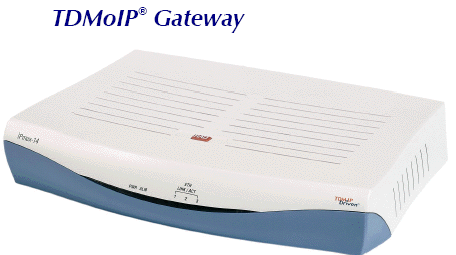




IPmux-14 from RAD
IPmux-14 Description (IPMUX-14/4T1/UTP/UTP)
IPmux-14 from RAD is a TDMoIP gateway optimized for small and medium-sized enterprise sites. The IPmux-14 offers Ethernet-based access, as well as extension of TDM-based legacy services over packet switched networks.
IPmux-14 Features
The IPmux-14 offers TDMoIP CPE (Customer Premises Equipment) for the small and medium-sized enterprise sites, offering TDM leased line extension over a packet switched network and controlled Ethernet access
TDMoIP technology, implementing the emerging IETF, MPLS/FR Alliance, ITU-T and MEF standards for Pseudo-Wire Emulation Edge-to-Edge (PWE3):
E1/T1 communication over IP and Ethernet networks with the IPmux-14
Support for both framed (full or fractional) and unframed E1/T1 using the IPmux-14
- Minimal processing delay
- Configurable jitter buffer compensation for network packet delay variation
- Dedicated external clock port
- QoS support by labeling IP level priority Type of Service (ToS) and VLAN tagging/priority labeling according to IEEE 802.1p&Q Three Ethernet ports, two
- for user side and one for network access The Ethernet user ports of the IPmux-14 offer:
Transparent Ethernet bridging
User data bandwidth and access control through rate limiting and VLAN filtering
VLAN classification through double VLAN tagging (stacking) Four E1 or T1 TDM ports available on the RAD IPmux-14 Management via ASCII terminal, Telnet host, Web terminal or SNMP-based network management station Provisioning and monitoring of TDMoIP services using the RADview Service Center for TDMoIP applications The IPmux-14 is a compact, 1U high enclosure ETHERNET
CAPABILITIES OF THE IPMUX-14
IPmux-14s internal Layer-2 Ethernet switch supports three Ethernet ports. One port serves as a network interface and the other two serve for user Ethernet traffic. Each Ethernet port of the IPmux-14 supports:
Configurable port-based rate limiting for bandwidth control
Configurable port-based VLAN membership for ingress traffic restriction
Configurable port-based VLAN tagging; a VLAN tag is added resulting in a double tagging (VLAN stacking) when an already tagged frame is witched. The device supports standard IP features, such as ICMP (ping),ARP, next hop and default gateway.
TDMoIP PERFORMANCE OF THE
IPmux-14 (IPMUX-14/4T1/UTP/UTP )
IPmux-14 provides a legacy over Ethernet/IP solution supporting transmission of E1/T1 streams over IP and Ethernet-based networks. IPmux-14 converts the data stream from its user E1/T1 ports into packets for transmission over the network. The addressing scheme of these packets is IP or MPLS. These packets are transmitted via the IPmux-14 Ethernet link port to the network. A remote IPmux converts the packets back to TDM traffic. High-performance buffering and forwarding techniques are used to achieve end-to-end processing delay as low as 3 msec. IP packet size is configurable. A greater packet length results in greater processing delay, yet smaller bandwidth overhead is achieved. An enhanced buffering mechanism in the IPmux-14 compensates for packet delay variation (jitter) of up to 200 msec in the network. Assigned, IANA-registered UDP socket number for TDMoIP simplifies flow classification through switches and routers.
IPmux-14 TDMoIP QoS SUPPORT
IPmux-14 supports VLAN tagging and priority labeling according to 802.1p&Q. TDMoIP frames are assigned (tagged) a dedicated VLAN ID. The ToS or Diffserv of the outgoing TDMoIP frames are user-configurable. This allows the TDMoIP packets to be given a higher priority by the network switches and routers. TDMoIP TIMING
Synchronization between TDM devices is maintained, by deploying advanced clock distribution mechanisms. The clocking options are:
Internal the master clock source for the TDM circuit is provided by the IPmux-14 internal clock oscillator
Loopback the transmit clock is derived from the E1/T1 ports receive clock Adaptive the clock is recovered from the Ethernet network interface External an external clock source to synchronize the device via its station clock port. ETHERNET INTERFACE OF THE IPMUX-14
IPmux-14 supports the following Ethernet ports:
One network port (UTP or fiber optic)
Two user ports (both UTP or UTP and fiber optic). The network and user portsprovide autonegotiation, VLAN tagging and rate limiting.
IPmux-14 TDM INTERFACE (
IPMUX-14/4T1/UTP/UTP )
Four standard E1 or T1 ports provide connectivity to any standard E1 or T1 device. E1 and T1 interfaces support the following:
Integral LTU/CSU for long haul applications
E1 balanced and unbalanced or T1 options
G.703 unframed and G.704 framed modes
CAS and CRC-4 bit generation (E1)
D4/SF and ESF framing (T1)
Hardened version IPMUX-14/H/4T1/UTP/UTP is available for extreme temperatures
such as enclosures where the temperature is not controlled.
DIAGNOSTICS with the RAD IPmux-14
IPmux-14 supports remote and local loop testing.
Alarm detection and insertion are supported together with error statistics. These include SES/UAS statistics, LOS/AIS physical layer alarms, and remote/local loopback test modes. Standard E1 or T1 alarms are transmitted end-to-end.
The following physical layer alarms are supported: E1/T1 port LOS, AIS, LOF, LCV.
IPmux-14 performs an internal built-in test (BIT) after power up. The results of the test are visible via the local terminal. IPmux-14 monitors LAN and IP layer network condition statistics, such as packet loss and packet delay variation (jitter). The events are stored in log files.
Fault isolation, statistics and event logging are available on the IPmux-14
The minor and major alarms can be relayed to a remote alarm device via dedicated pins of the external clock RJ-45 connector on the IPmux-14
MANAGEMENT OF THE IPmux-14
IPmux-14 can be configured and monitored locally via an ASCII terminal, or remotely via Telnet, Web browser or RADview. Management traffic can run over a dedicated VLAN The RADview Service Center and Element Manager packages control and monitor TDM over IP (TDMoIP) devices and circuits. The Service Center s intuitive GUI, point-and-click functionality and easy-to-follow wizards increase the efficiency and accuracy of the service provisioning process. Software download is supported via the local terminal, using XMODEM, or remotely, using TFTP. After downloading a new software version, IPmux-14 automatically saves the previous version in non-volatile memory for backup purposes. Similarly, copies of the configuration file may be downloaded and uploaded to a remote workstation for backup and restore purposes.
Common models are:
IPMUX-14/4T1/MM13LC/UTP
IPMUX-14/4T1/SM13LC/UTP
IPMUX-14/4T1/UTP/UTP
IPMUX-14/H/4T1/UTP/UTP
IPMUX-14/4E1/UTP/UTP
IPMUX-14/4E1CX/UTP/UTP
IPmux-14 data sheet (pdf 852)